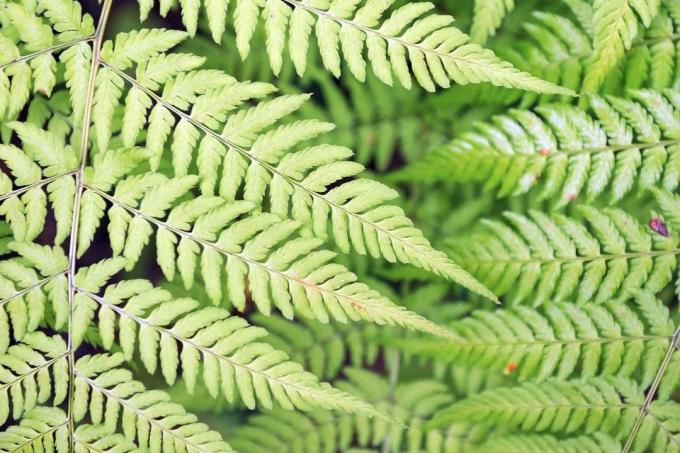
table of contents
- Fern species in Germany
- Classification of toxicity
- Three highly poisonous fern species
- Bracken (Pteridium aquilinum)
- Common fern (Dryopteris filix-mas)
- Japanese cycad (Cycas revoluta)
- frequently asked Questions
Ferns are unproblematic contemporaries in many ways. They are easy to plant, quietly spread without any great effort, and develop beautiful leaf fronds. However, caution is advised as some ferns are very poisonous. Here you can find out whether yours is one of them.
In a nutshell
- Fern is one of the oldest plants in the world
- all fern species are considered to be slightly poisonous
- Poisoning is usually only possible with oversized quantities
- three ferns very poisonous
- Most poisonous fern: bracken
Fern species in Germany
Ferns generally like it shady and humid, which is why they are often found in forests or by streams. Thanks to its particularly beautiful leaf fronds, the fern is also popular as an ornamental plant in the garden or in the house. There are 12,000 species of ferns worldwide, around 170 of them in Europe. The most common ferns are
- Stag's tongue fern (Phyllitis scolopendrium)
- Brown-stalked striped fern (Asplenium trichomanes)
- Woodland fern (Athyrium filix-femina)
- Common fern (Dryopteris filix-mas)

Ferns are also becoming increasingly popular as an ornamental plant for the home. However, in contrast to domestic ferns, the indoor ferns need warmth and a lot of light. Popular indoor ferns include:
- Sword fern (Nephrolepis)
- Maidenhair fern (Adiantum capillus-veneris)
- Antler fern (Platycerium bifurcatum)
- Potted fern (Polypodium vulgare)
- Nest fern (Asplenium nidus)

Classification of toxicity
Most fern plants are classified as mildly poisonous. Neither species is completely non-toxic. However, in most cases such a large amount has to be eaten to suffer poisoning that it seems almost impossible. Symptoms of mild fern poisoning would be diarrhea and vomiting. There are also fern plants that contain a high concentration of toxins and are therefore very dangerous for humans. In some cases, breathing in the spores is enough to cause poisoning. This is why garden owners should know their ferns well and plant them wisely.
Above all, pet owners should make sure that the plant with its magnificent foliage is not eaten by animals. Both grazing animals and domestic animals can get sick after consuming poisonous fern. Symptoms of illness that could lead to death include the following:
- (bloody) vomiting
- (bloody) diarrhea
- stomach pain
- Signs of paralysis
- Increased saliva production
- Tremble
- cramps
- Difficulty breathing
Consumption of poisonous ferns also threatens children with life-threatening symptoms. Then there are symptoms similar to those in animals.
Three highly poisonous fern species
Bracken (Pteridium aquilinum)
The entire bracken plant is highly toxic. The bracken is therefore considered to be the most poisonous fern in Germany. It contains toxins such as hydrogen cyanide glycosides, thiaminase and pteridine. These substances are not broken down even when they are dried. The enzyme thiaminase destroys the vitamin B1 in the organism when it is absorbed and can cause disturbances in movement. In addition, bracken poisoning promotes the development of tumors as well as esophageal and gastric carcinomas. Even skin contact with spores or leaves can cause poisoning. You should therefore wear gloves when planting and caring for it.

- Location: partially shaded to shady
- Soil: fresh to moderately moist, gravelly to sandy
- Planting time: spring
- Height: 1.5 to 2 meters
- Occurrence: Forests, meadows, pastures
- Leaves: green, long-stalked triangular fronds, three to four pinnate, slightly hairy
- Winter hardiness: hardy
- poisonous: entire plant highly poisonous for humans, pets and grazing animals
Note: Cultivate the bracken with appropriate protective measures. If you are a pet owner or have children with you, you should enclose the plant with a protective fence.
Common fern (Dryopteris filix-mas)
The real worm fern is also known as common or common worm fern or male fern. It gets its name from its previous use as a wormer treatment in humans. Its ingredients, such as acylphloroglucinols and tannins, caused side effects even then that led to death. Symptoms of poisoning to date are:
- nausea
- diarrhea
- Visual disturbances
- Blindness
- headache
- Liver damage
- Fainting spells
- Heart failure
- Damage to the respiratory tract
The external use of the worm fern is also dispensed with today.

This fern species is just as dangerous for pets and farm animals. In the past, it was used as a wormer for animals, but the danger that can lead to death in animals is now known.
- Location: partially shaded to shady
- Soil: moderately dry to fresh, sandy to loamy
- Planting time: spring
- Height: 60 to 100 centimeters
- Leaves: short, pointed and bi-pinnate leaves on up to 120 centimeters large fronds, upper side dark green, underside light green
- Winter hardiness: hardy
- toxic: entire plant is toxic to humans, pets and grazing animals
Japanese cycad (Cycas revoluta)
The Japanese cycad is also known as Sago Palm Fern. The seeds and roots contain the glycoside cycasin, which can lead to liver damage, bloody diarrhea and neurogenic effects in humans. The fern plant should also be planted out of the reach of animals. The fern is just as poisonous for them as it is for humans. The fern causes disturbances in the gastrointestinal tract and the liver. Animal experiments with rodents have even shown a carcinogenic effect.

- Location: shady to partially shaded
- Soil: fresh to moderately moist, sandy to loamy
- Height: 2 to 3 meters
- Leaves: dark green, leathery and simply pinnate fronds up to two meters long
- Winter hardiness: no - sensitive to frost
frequently asked Questions
Call the emergency doctor and the poison control center responsible for you. The staff there will tell you what you can or should do.
Gloves and long-sleeved clothing should be worn when planting, cutting, or grooming. After working with the plant, clean your hands properly and clean the clothing you have used separately.
The above three very poisonous ferns are also very dangerous for pets and grazing animals. Other fern species are more toxic to smaller pets than to humans. However, animals often have a sense of which plant they shouldn't eat. In the event of poisoning, call the animal emergency number or your veterinarian immediately.
